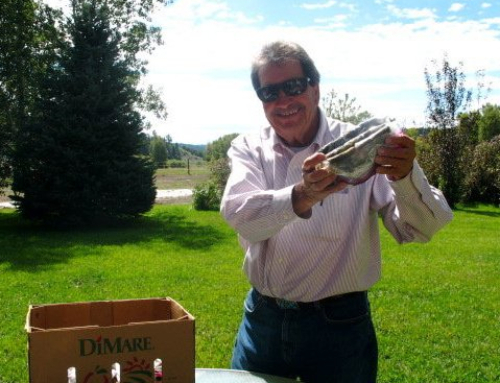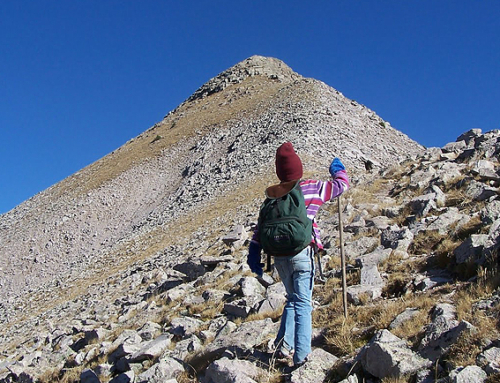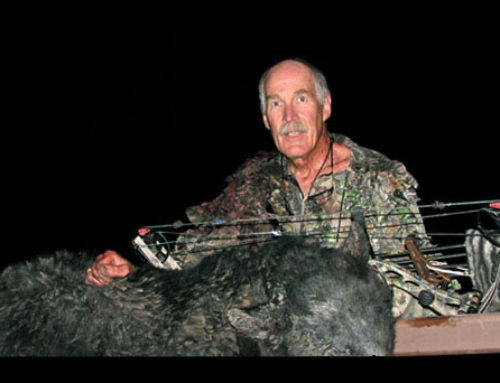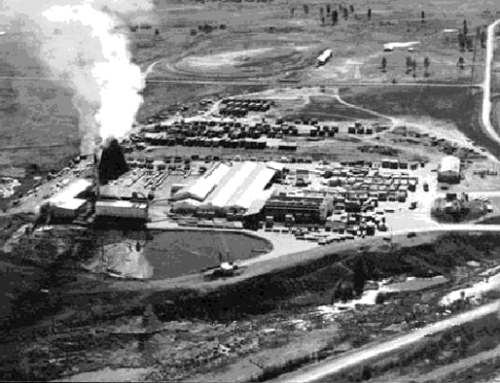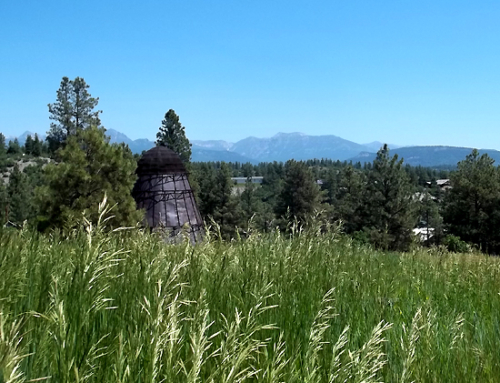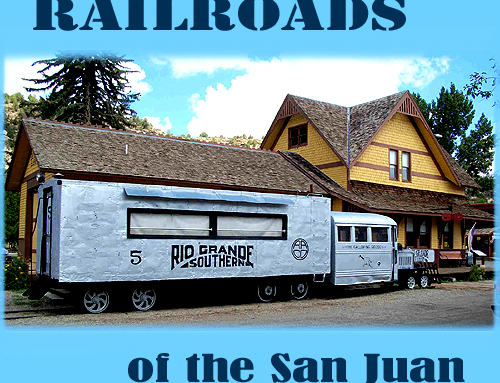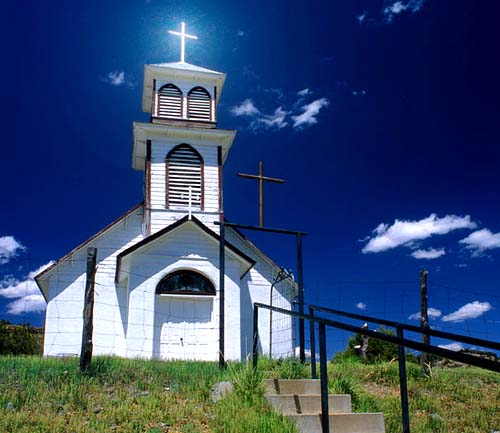 Article posted by Norm Vance
Article posted by Norm Vance
St. John the Baptist Church Pagosa Junction, Colorado
The present church, built on a hillside above the now abandoned railroad yards, is the third in a line of Catholic Churches built to serve the needs of the people in the Pagosa Junction area. Two previous churches built near the San Juan River had been washed away in floods. The first church was built in 1911 and the present one was dedicated in 1927. Masses are offered at the Missions by special request.
See more related history links below:
20th Century History with Margaret Archuleta
Pagosa Country’s Treasures and Spanish History
The following text Courtesy of Center of Southwest Studies, Fort Lewis College
The Center of Southwest Studies, Fort Lewis College
HISPANIC CULTURE
Settlement by Europeans and people of mixed ancestry is relatively recent in the San Juan region. Ute Indians, and to a lesser extent Navajo Indians, were present in southwestern Colorado by A.D. 1300, approximately three centuries prior to the arrival of Spaniards in New Mexico and five and a half centuries before the United States took possession of what became southern Colorado in 1849. Spanish-speaking people had been in the lower Chama River Valley since the mid-1700s, and only gradually did they move northward into the upper valley, where Indian raids still were discouraging newcomers as late as 1860. Nevertheless, by then, Tierra Amarilla was a permanent settlement. These families farmed and pastured sheep and goats on nearby land. As Hispaños subsequently moved into the San Juan Basin and the San Juan Mountains, the majority arrived from the south, either traveling by way of the Chama River or moving from previous homes in the Chama River Valley. In the 1870s Hispanics also were moving westward from the San Luis Valley, which had been settled in the 1850s by people from New Mexico.
When the mining excitement began about 1860, most prospectors entered the San Juan region by way of the Chama River. In 1859 U.S. Topographical Engineers under J. N. Macomb traveled up the Chama River to Pagosa Springs, and within weeks the Abiquiú, Pagosa, and Baker City Toll Road was organized on paper by Abiquiú’s Indian agent Albert H. Pfeiffer, Charles Baker, and others. With high hopes for profiting from the mining excitement, they also proposed moving the Indian agency to Pagosa Springs, and Pfeiffer even claimed ownership of the hot springs, although documents to prove such a claim are lost or nonexistent. The springs had long attracted many Indians to the healing waters, and a number of shelters had been built by the native people on the rocks. (See also, Pfeiffer-Navajo duel in the TCP Case Studies.) Establishment of Camp Plummer, later called Fort Lowell, at Tierra Amarilla in the 1860s provided increased safety for settlers and travelers in the Chama River Valley and north toward the San Juan Basin, in the area of the border between Colorado and New Mexico Territories. Following the Brunot Agreement signed in1874, freighting into the San Juan mines and settling of land in southwestern Colorado increased rapidly.
Before Fort Lewis was established in 1878, several Anglo people had settled at Pagosa Springs, one even claiming a mineral right that would be litigated for years. A few cabins were built, but most people camped there only in summer months while seeking cures for various ailments, and one such group, including a woman and boy leading a blind man, came in 1873 from Del Norte by way of the old Indian trail over Wolf Creek Pass. The arrival of Fort Lewis changed the economy and settlement of the area greatly as large quantities of corn, beef, hay, logs, shingles, and boards were required by the new post, although the Army post moved to the La Plata River within only three to four years.
While the post existed on the north side of the hot springs, a cluster of buildings and bathhouses was growing on the southeast side of the San Juan River and later occupied the fort’s site. The pine forests around Pagosa Springs and north of it attracted logging, and meadows became cattle pastures. Southwest of Pagosa Springs, the land was better suited to agriculture, with hay becoming an important crop. When Archuleta County was created in 1885, Pagosa Springs became its county seat.

I. Hispanic Settlement in Archuleta County
Published history about Pagosa Springs conveys the impression that few if any Hispanic people lived in the area, but the name alone of Archuleta County corrects this picture. The Archuleta family came from the Chama River Valley to Conejos County (in the portion that became Archuleta County). J. M. Archuleta, Sr., was elected state senator from that county in 1876, but county officers were primarily Anglo-surnamed, then and later, when Archuleta County was created from the western part of Conejos County in 1885. The Archuleta family grazed livestock on the west side of the Continental Divide, on Archuleta Mesa. Trouble arose because Pagosa Springs’ Anglos felt that they were taxed too much and the Archuletas were taxed too little while they were being given preferential treatment by Ute Indians to use their range land for grazing and to farm on shares. An indication of ethnocentric attitudes is found in Los Pobladores, which reports that when the school board at Pagosa Springs was elected in 1886 (or 1885), Anglos “won out over the Mexican gang 15 to 1,” according to the schoolteacher. Increasing numbers of Hispanic people were settling along the Colorado-New Mexico border, while Anglos who attempted to settle in the eastern end of the Southern Ute Indian Reservation were evicted until allotment of the reservation in 1887. Regardless of existing ethnic tensions, the county and Pagosa Springs were very dependent on business with Hispanic sheep owners, herders, and the region’s wool brokers, as sheep raising was a major industry.

The Gomez-Garcia-Archuleta family heirlooms, a hand woven silk shawl and an emerald and gold necklace. These objects were brought from Spain on the Juan de Onate expedition in 1626. A few years ago the necklace was requested and put on display at the Smithsonian Institute in Washington D.C. These items are kept in a bank vault and are the most valuable objects in Pagosa Country.
Article continues…
Settlers also included individuals who were married to Spanish-speaking women. One such couple was Christian Stollsteimer and his wife Maria Amanda Barada, adopted daughter of famed fur trader Antoine Roubidoux. Beginning in about 1880, they ranched near the junction of the Piedra River and Stollsteimer Creek, at what became known as Francé. Stollsteimer was a partner with Albert Pfeiffer and others in grazing livestock. When Ute Indians protested that their cattle were trespassing on Indian land, Pfeiffer was able to get permission by identifying himself as part-owner of the livestock. Their original herd is said to have been brought to the Piedra River from the Rio Grande drainage, where both Pfeiffer and Stollsteimer had homes between Del Norte and South Fork; but the route used for moving the cattle across the Continental Divide is unknown. (The Wolf Creek Pass trail is said to be too precipitous on the west side for trailing cattle.) The Archuleta and Stollsteimer families were compatible, as is evidenced by the marriage of one of Christian’s daughters to an Archuleta.
In time, several families from the Conejos, Colorado, area moved west, joining other Hispanic people from the Chama Valley who lived in along the Piedra River and on or near the Southern Ute Reservation. Marriage between Ute Indians and Hispaños occurred. Stores in the area were owned by Chama River entrepreneurs. Besides farming and ranching, Hispanics worked at lumber mills, holding jobs especially on freight wagons, and at railroad facilities. Archuleta County’s Hispanic people occupied scattered farms or clustered settlements, not plazas built on a grid. Although there were Hispanic homes in La Plata County’s towns, like Ignacio and Bayfield, they were not numerous in Pagosa Springs. Homes and sheds were constructed with the materials that were present locally—normally adobe or logs.
II. Religion
Generally speaking, most Hispanic settlers in southern Colorado and northern New Mexico were Roman Catholic. In rural areas, the absence of resident priests caused the people to practice their religion without close supervision, guidance, or Church sacraments – except when a priest visited, as was the case during the early years of settlement in southwestern Colorado. The absence of established churches belies the presence of Hispanic, Catholic settlers.
Without priests, the devout people frequently had small shrines with sacred objects in their homes or even built oratorios where families and neighbors could gather for prayer. La Cofradia de Nuestro Padre Jesus Nazareno (also called La Hermandad de Nuestro Padre Jesus) was a brotherhood of men (often called Penitentes) who took care of many of the spiritual and social needs of the people. Meeting in a morada, a meetinghouse, they were assisted by women, who were called auxiliadores. One can assume that many men in the San Juan region were Penitentes, meeting at their moradas. Although Lenten and Holy Week rites have captured the attention of many gossips and writers, the Penitentes also were attending to important daily needs of their neighbors, such as performing wakes and burials, providing for widows, and even serving justice. Because the brotherhood was being suppressed by the Catholic Church in the latter part of the 1800s and the first half of the 1900s, secrecy became the norm.
Nonetheless, the brotherhood was very strong among rural residents in the area round Abiquiú, New Mexico, so it is reasonable to assume that the first Hispaños who moved up the Chama River Valley into the San Juan Basin were Penitentes. The same can be said about rural people who moved into the San Juan region from the San Luis Valley, where the brotherhood had numerous moradas until quite recently. Historian Virginia Simmons learned from a Penitente that there “used to be Penitentes around Pagosa Springs,” for instance, but it is unknown whether there are any now. A descendant of a family, many of whose members were Penitentes, says there were quite a few moradas but declined to reveal their location even to a relative. It seems unlikely that moradas would be very active today, since the numbers of brothers have decreased in the past few decades, even in the San Luis Valley, although some remain.
At least one Catholic chapel, built by local residents, did exist. For example, at Francé, a small Catholic church was built by the Stollsteimer family at their ranch on the Piedra River, southwest of Pagosa Springs, for services conducted by visiting priests and for private prayer. This adobe structure is still standing and is used on occasion.
Reflecting the Catholic Church’s inactivity rather than Hispanic numbers in southwestern Colorado, parishes were not organized in this region until the turn of the century. Rico was an exception with a small Catholic church built by about 1890, because Italians may have increased the need. Silverton’s Catholic church was built in 1905. In 1906 Sacred Heart Parish was established in South Durango for Hispanic and Italian Catholics, at first using an old schoolhouse that was purchased for its first church. Durango’s parish priests traveled to outlying missions at Ignacio, Allison, Hesperus, La Posta, Tiffany and Marvel. In 1940 a church was built at Ignacio, primarily for Hispanic people with a few Ute Indians as well, and its priest took charge of the missions to the east. Durango had Saint Columba Church and School established by an order of the Sisters of Mercy in 1881-1882. Although the ethnic orientation of Saint Columba’s parish was Irish, the Catholic Church was a very prominent early element of the community. Pagosa Springs had Saint Edwards Catholic Church, which was built in 1894 and burned in the 1950s. The Catholic Churches were all under the Bishop of Pueblo until the establishment of the Theatine Order in Durango, operating out of Sacred Heart Church in Durango. Pagosa Springs’ second Catholic Church, the Immaculate Heart of Mary, was built in 1948 and established its own parish in 1952.

